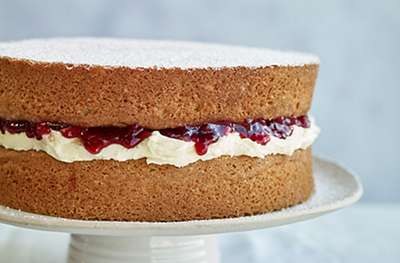0 added
Item price
£2.25Price per unit
£9/kg
Please note, we take every care to ensure the product, allergen and recipe information displayed is correct. However, should a product be unavailable, alternatives may be displayed and/or a substitution provided. If you have an allergy or intolerance, please always check the product label before use.
Before you start, make sure all your ingredients are at room temperature and the butter is soft. Preheat the oven to 190 degrees C, gas mark 5. Cut 2 circles of baking parchment to fit in the bases of 2 x 20cm sandwich tins; set aside. Tear a piece of the butter wrapper and use to grease the insides of the tins with a thin layer of butter. Hold 1 tin at an angle (so it’s almost on its side) and sprinkle a little flour inside. Turn and tap the tin to move the flour over the sides (not the base), until they’re coated all the way around. Repeat with the other tin, then put the parchment circles in the tins.
Sift the flour and a pinch of fine salt into a medium bowl. In a jug, lightly beat the eggs with the vanilla paste; set both aside. Use electric beaters or a freestanding mixer to beat the butter and sugar together. Start on a low speed until combined, then increase the speed to high and beat for 8-10 minutes, scraping down the bowl every now and then, until the mixture is very pale and fluffy. It should be almost mousse-like.
Continue mixing on a high speed while gradually adding the beaten egg and vanilla paste. Adding it slowly reduces the risk of curdling. If the mixture does start to look grainy, add a spoonful of the sifted flour. When you’ve added nearly all the egg and vanilla, reduce the speed to low. When all the egg mixture is added, stop beating and tip in the flour and salt. Carefully fold it in, ideally using a rubber spatula; scrape around the edge of the bowl, then gently draw the spatula through the centre of the mixture in a cutting motion. Repeat until all the flour is incorporated; a light touch helps keep the air in the mixture. Fold in the milk to bring the mixture to a ‘dropping consistency’ (it should drop off the spatula easily when tapped).
Divide the mixture evenly between the tins. Use the back of a spoon to spread the mixture to the edges of the tins, then even the surface, making a slight dip in the centre of each (the cake will rise more in the middle, so a dip helps achieve a level sponge). Bake in the centre of the oven, preferably on the same shelf (without the tins touching), for 18-22 minutes. Check the cakes after 15 minutes (not before); if they aren’t baking evenly, rotate them or swap them over. The cakes are ready when springy to the (gentle) touch and starting to come away from the edges. Be careful not to overbake; the sponges will dry out.
Carefully run a palette knife around the edge of each sponge to release from the tins, then turn upside down onto a wire rack. Peel away the parchment and leave to cool completely. Meanwhile, make the filling: put the butter in a bowl and use electric beaters to beat until fluffy (1-2 minutes). Sift over the icing sugar, lightly stir in with a rubber spatula, then use electric beaters on a high speed to mix until fully combined (about 30 seconds). Quickly mix in the vanilla; set aside.
Once the sponges are cool, transfer 1 sponge to a serving plate, turning it over so the flat side is on the base. Pile all the buttercream on top, then use a palette knife to spread it to the edges. Keep the buttercream uneven to create height between the sponges and make plenty of pockets for jam. Spoon over the jam and spread it out to the edge of the sponge. Put the second sponge on top, the same way up as it cooled. Use a fine sieve to dust about 2 tsp icing sugar over the top.
Typical values per serving when made using specific products in recipe
Energy | 2,298kJ/ 550kcals |
|---|---|
Fat | 31g |
Saturated Fat | 19g |
Carbohydrates | 61g |
Sugars | 44g |
Fibre | 1.3g |
Protein | 5.6g |
Salt | 0.3g |
Book a slot to see product availability at your nearest Waitrose & Partners store
0 added
Item price
£2.25Price per unit
£9/kg0 added
Item price
45pPrice per unit
90p/kg0 added
Item price
£3.40Price per unit
28.3p each0 added
Item price
£5.00Price per unit
£76.93/kg0 added
Item price
£3.00Price per unit
£3/kg0 added
Item price
£1.85Price per unit
81.4p/litre0 added
Item price
£2.25Price per unit
£9/kg0 added
Item price
£2.65Price per unit
£2.65/kg0 added
Item price
£5.00Price per unit
£76.93/kg0 added
Item price
£1.40Price per unit
£3.09/kg